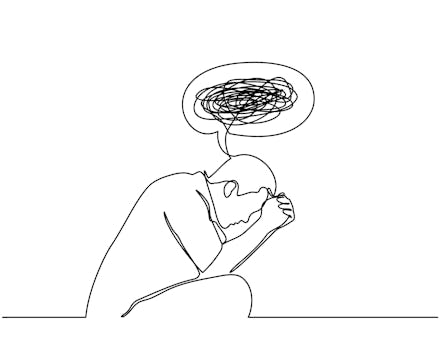How to help someone who's having a panic attack

Years ago, when I was still a kid, I was sprawled on the sofa, watching TV, when I suddenly felt a tingling in my fingertips. My senses heightened as the electric sensation rippled up my arms and spread across the rest of my body. My insides twisted with dread. A chill settled over me. Reality seemed to unravel, and I was convinced I was dying. I didn’t realize it at the time, but I was experiencing a panic attack.
According to the Mayo Clinic, a panic attack is an episode of intense fear that comes on suddenly, in the absence of any real danger. They can cause a sense of imminent doom, or even death, as well as extreme physical symptoms, including shortness of breath, numbness or tingling, a racing heart rate, and chest pain. Panic attacks are similar to what people refer to as anxiety attacks but the former tend to yield more intense physical symptoms.
“A panic attack is this full-body, somatic experience,” Cathie Gordon, a California-based mental health counselor, tells Mic. “The body goes into this fight-or-flight response…. Literally, the body is preparing for action.” While this fight-or-flight response might have offered an evolutionary advantage to humans (helping us fend off danger), panic attacks hijack this response so that it’s no longer helpful. “The gas pedals just keep running,” Gordon says.
Although most people experience one or two panic attacks throughout their lives, they often stop having them, perhaps when a stressful period passes, per the Mayo Clinic. In my case, I've had maybe only two more panic attacks since the one I described earlier. I suspect a string of deaths in my family when I was growing up contributed to them; my panic attacks subsided as more time passed after those deaths. On the other hand, repeated panic attacks that seem to come out of the blue, as well as constant fear of another attack, could indicate a panic disorder, according to the Mayo Clinic.
Panic attacks can be downright terrifying. Here are some ways to help someone who may be experiencing one:
Learn to recognize the signs of a panic attack
Usually, someone who’s having a panic attack will describe having an overwhelming traumatic experience that’s preventing them from functioning, Gordon says. They might mention that their heart is racing, or that their blood pressure is rising. “It’s not uncommon that people think they’re having a heart attack,” Gordon says, and indeed, a panic attack can look a lot like a heart attack. If you’re really unsure of which one you’re dealing with, she suggests heading to the ER.
Let the person having the panic attack know they’re not alone
Panic attacks can feel incredibly lonely, even if there are other people around., That can, in fact, make them feel even more terrifying. If someone you know is having a panic attack, “the first thing to do is make eye contact,” Gordon says. Tell them to look into your eyes and reassure them you’re here with them. Hold their hands or shoulders, if that feels comfortable for them.
Bring their focus into the present
Since anxiety is future-focused, grounding the person having a panic attack in the here and now can help soothe them. “You’re bringing their focus out of whatever is causing the panic,” Gordon explains. Start by doing deep, full-belly breathing with them, holding each inhale and exhale for two counts. Keep gazing into their eyes and reassuring them, “I’m right here with you.”
Since anxiety is future-focused, grounding the person having a panic attack in the here and now can help soothe them.
Later, engage them in tasks that use their five senses. For instance, ask them to find 20 blue items in the room, or to focus on squeezing and releasing your hand. Ask them if they can hear your voice. Tap their left thigh, then their right, back and forth in a rhythmic fashion, which mimics the left and right brain stimulation that happens in deep REM sleep. Gordon says this approach is used in EMDR, a type of psychotherapy that may help people process and recover from trauma.
Ask them to focus on a body part that feels neutral
When someone is having a panic attack, they tend to fixate on their pounding heart, which probably only ends up scaring them even more, Gordon says. Ask them to focus instead on body part that feels more relaxed — maybe their foot or hand, for instance.
Ask them to imagine a place where they feel safe
Once you feel like you’ve helped calmed down the panic attack sufferer’s nervous system and alleviated their physical symptoms, focus on stilling their mind by asking them to imagine a place in their life where they feel really restful and peaceful. Ask them how they feel in this place, who would be there with them, and what that person is like.
If the person you’ve helped through a panic attack experiences them on a recurring basis, help is available for them in the form of therapy, as well as medication. If you want to suggest they seek help, do so from a place of empathy. Start by validating their suffering by saying something along the lines of “I just watched you suffer with this, and I feel for you,” and then asking if they’d be open to learning some tools or getting some support around their panic attacks. “There’s a lot we can do with anxiety before it gets to a panic attack,” Gordon says.